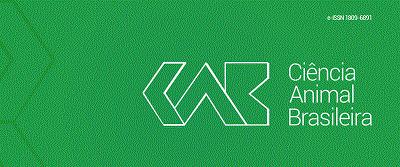Resumo em Português:
Resumo O objetivo deste experimento foi avaliar o efeito da época do ano sobre a biometria testicular e qualidade do sêmen fresco e congelado de touros Pantaneiros. Seis touros foram submetidos, mensalmente, durante um ano, à mensuração testicular e à coleta e congelamento do sêmen, utilizando-se meio à base de tris-gema-glicerol. O comprimento e o volume testiculares foram maiores (P < 0,05) nos meses de junho (11,1±0,8 cm; 652,7±138,0 cm3), julho (11,0±0,9 cm; 616,4±156,2 cm3) e setembro (11,8±0,8 cm; 692,4±141,3 cm3) que em outubro (9,4±1,2 cm; 498,5±154,3 cm3) e novembro (10,3±1,1cm; 560,0±111,8 cm3). A concentração espermática foi maior (P < 0,05) no mês de agosto (1265,0±436,8 x106sptz/mL) que nos meses de outubro, dezembro e janeiro (591,6±192,0; 627,5±314,4; 502,5±172,9 x106 sptz/mL, respectivamente). Não houve efeito da época do ano sobre a qualidade do sêmen fresco e congelado (motilidade, vigor, defeitos totais e integridade acrossomal) (P > 0,05). Conclui-se que touros Pantaneiros, na região do Distrito Federal, podem ser utilizados em programas de acasalamento natural em todas as épocas do ano. Visando ao enriquecimento do Banco Brasileiro de Germoplasma Animal com maior número de doses, sugere-se o congelamento do sêmen entre os meses de junho e agosto, embora este não apresente perda de qualidade nas diferentes épocas do ano.
Resumo em Inglês:
Abstract The purpose of this paper was to investigate the effect of the season of the year on testicular morphology, fresh and frozen/thawed semen quality from Pantaneiro bulls bred in Brasilia, DF. Six bulls were submitted, once a month for one year, to evaluation of testicular measurements, semen collection using an artificial vagina and cryopreserved with medium containing Tris-based, egg yolk and glycerol. The testicular length and volume were greater (P < 0.05) in June (11.1±0.8 cm; 652.7±138.0 cm3), July (11.0±0.9 cm; 616.4±156.2 cm3), and September (11.8±0.8 cm; 692.4±141.3 cm3) than October (9.4±1.2 cm; 498.5±154.3 cm3) and November (10.3±1.1 cm; 560.0±111.8 cm3). The sperm concentration was greater (P<0.05) in August (1265.0±436.8 x106sperm/mL) than October, December and January (591.6±192.0, 627.5±314.4; 502.5±172.9 x106/mL). There was no effect of season on the quality of fresh and frozen semen (motility, vigor, total defects and acrosome integrity) (P > 0.05). In conclusion, Pantaneiro bulls, bred in the Midwest region of Brazil, can be used in natural mating programs in all seasons. Aiming to improve the Brazilian Animal Germplasm Bank with a higher number of samples collected, we suggest that the freezing of the semen is done between June and August, although there will be no losses of semen quality at any time.
